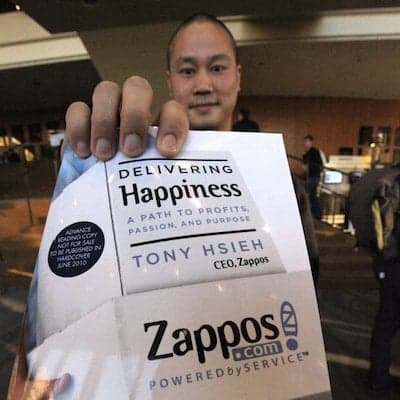The name Tony probably doesn’t mean much to you—unless you’re an employee of Zappos.com or one of the 400,000 people who purchased and read Delivering Happiness. In which case, you know exactly which Tony I’m talking about.
Tony Hsieh started as the CEO of the e-commerce powerhouse Zappos.com in 2000. Since then, he’s helped boost sales to over $1 billion a year and played a significant role in Amazon’s acquisition of the company in 2009.
But what’s even more impressive is that he’s established an unmatchable company culture—one that’s generated a buzz not unlike a cult following—centered around the fact that an employee “happiness quotient” is crucial to the growth and sustainability of a business.
Tony’s management style might seem impossible to replicate if you’re not a CEO or a billion-dollar business with infinite resources—but with a little adaptation, managers at any level can employ his leadership tactics. Here are five of Tony’s most influential habits and easy ways you can replicate his success with your team.
What Tony Does: Communicates Openly and Honestly with Employees
Instead of letting company news slowly trickle down to the ranks in typical corporate fashion, Tony is known for communicating with all employees directly via personalized email updates, all-hands meetings, and informal team gatherings, making sure that significant company news comes straight from the top.
But it’s not a one-way lecture—Tony takes time to really listen to his employees, too. As a result, Zappos employees feel comfortable voicing their opinions and openly discussing their ideas with managers, executives, and co-workers alike.
What You Can Do
Somewhere between the tight-lipped, hard-to-read manager and the open, over-sharing colleague, there’s a well-balanced, approachable leader. To perfect that role and channel your inner Tony, begin by communicating with your team as often as possible, keeping them up-to-date on company and department goals and big decisions that will affect them. Sure, there might be information you can’t share, but communicating as openly as possible will help your employees feel like a significant part of the company.
And keep in mind that your communication should go both ways. An important aspect of managing others is learning how to stop talking and start listening—to their needs, frustrations, and fears. Help your employees feel comfortable expressing their opinions by holding weekly brainstorming sessions or creating an anonymous suggestion box.
What Tony Does: Focuses on Fun
To Tony, fun is a priority—and that’s evident in the day-to-day life of his employees. Besides shoes and apparel, Zappos is known for the company events it hosts: costume parades, barbeques, and even an annual New Years Eve bash at the CEO’s home in Las Vegas—just to name a few.
But the fun isn’t limited to off-work hours. Tony also encourages employees to enjoy themselves inside the office—via internal events, interactive all-hands meetings, and dedicated time for employees to pursue their passion projects. As a result, employees are excited to come to work and spend time with their co-workers.
What You Can Do
Put a little fun in your management approach! Plan intra-department gatherings (e.g., potlucks, office Olympics, or themed meetings) that foster communication, creativity, team building, and flat-out fun. And don’t limit it to office hours—every so often, organize a nighttime outing, like bowling, a casual cocktail hour, or a bi-monthly team dinner. Make it known that you’re interested in getting to know your colleagues as people, not just as 9-to-5 worker bees—you’ll demonstrate that you appreciate your employees while humanizing yourself as a manager.
What Tony Does: Holds Employees to High Standards
At Zappos, everything is done according to a set of unique company values. Employees are not only required to memorize and be able to recite all 10 values on command, they’re encouraged to embrace and apply them in their everyday lives.
For example, “conducting business with integrity” (one of the core values) means that employees are encouraged to take pride in their work and that they’re held accountable for their behavior. At the same time, employees are expected to remain humble (another value), which creates a sense of teamwork and cooperation.
What You Can Do
Meet with your team to craft a set of values that speaks to your department’s goals and priorities. Challenge your employees to think about what they stand for, both as a department and as an entire company, and what values they deem critical for success. How does your department contribute to the overall business? What goals can you set to further those contributions? How is your team unique and how does it add value to your customers?
At the end of your brainstorming session, your values may include things like “we accept failure with grace” or “we win as a team.” Whatever you come up with, you’ll encourage collaboration, unify your team, and clarify your goals.
What Tony Does: Maintains a Level Playing Field
In everything he says and does, Tony conveys that all Zappos employees are created equal. In fact, not only does Tony open his home to employees for company get-togethers, but he shares his workspace as well. That’s right—even as CEO, he chooses to work at a desk in the middle of a sea of cubicles instead of sequestering himself in a corner office. And with that display of humility, Tony establishes an equal playing field with the rest of the company.
What You Can Do
You may not be able to change where you sit, but you can change the way you act. Make it a habit to walk around and chat with your team—often. Whether you have five or 15 employees, it’s important to make time for one-on-one interaction, outside of formal team meetings or annual performance reviews. Stepping outside your office shows that you’re interested in what’s going on with your team—and that will help your employees see you as a loyal leader, rather than their ultimate superior.
What Tony Does: Humbly Admits When He’s Wrong
As part of the company’s core values, employees are encouraged to admit to their mistakes. In fact, when Zappos suffered a $1.6 million loss (and in six short hours, to boot) because of a pricing snafu, Tony accepted responsibility for the massive hit to the bank. Instead of disappointing customers, he chose to honor the deep discount for everyone who purchased goods during the pricing glitch. As a result, Tony garnered fierce customer loyalty—but also demonstrated to his company and its stakeholders that honesty is the best policy.
What You Can Do
Don’t pretend to be all-knowing—and don’t expect your employees to be, either. Inspire them to take risks, admit when they’re wrong, and adapt when things don’t go as planned. To encourage this, try holding weekly team meetings where you highlight recent accomplishments and struggles, providing advice and assistance when necessary. Kick off the meeting by stating your own professional hurdles—revealing that you’re human and that you make mistakes will help your team feel comfortable admitting their challenges in return.
As Tony has demonstrated, if you lead by example, stick to your core values, and concede when necessary, your team will consistently deliver the best results—for you, for the team, and for the company as a whole.

